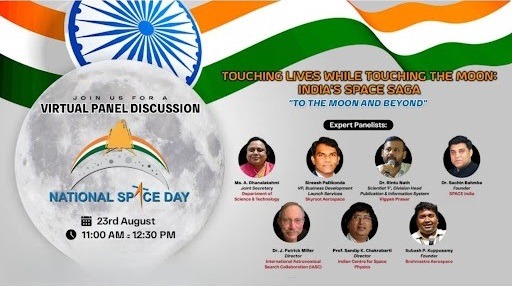The multitude of dedication, innovation, and marvels attained characterize India’s journey into space exploration. One such glorious initiative in this regard is its Chandrayaan program, due to which India has been able to carve a niche for itself within the global space community. Chandrayaan-3 was a real test of ISRO capabilities, which stood the epitome of success after a historic landing on the south pole of the Moon on August 23, 2023. In terms of this monumental success, not only would it prove the growing prowess of India in space technology, but it also inspired the declaration of August 23rd as National Space Day in the country—a glorious day for the country in attempts to immortalize its scientists, engineers, and visionaries.

Overview of the Chandrayaan Program.
The Chandrayaan program began in 2008 with the successful launch of Chandrayaan-1, the first Indian lunar probe. It discovered water molecules on the Moon, an international sensation, and ushers in the second mission, Chandrayaan-2, in 2019 to study the south pole of the Moon. Although the lander, Vikram, lost contact during the descent phase of the mission, its orbiter continues to work, sending data back to Earth from orbit. Lessons from Chandrayaan-2 led to Chandrayaan-3, a mission designed with an exclusive focus on one mission: to land successfully on the Moon’s surface.
Chandrayaan-3: The Historic Mission
Chandrayaan-3 was launched on July 14, 2023, with one clear objective in mind—to achieve a soft landing on the Moon’s south pole, a region that had never been explored earlier. This, therefore, becomes an area of immense scientific interest because of its possible deposits of water ice and the unique conditions that prevail there. The mission comprised a lander called Vikram and a rover called Pragyan, equipped with advanced scientific instruments that were intended to study the surface of the Moon, analyze soil samples, and explore the environment of the Moon.
On August 23, 2023, the Vikram lander executed an intricate and coordinated landing, which resulted in success in touching down at the designated area. This not only highlights potential within ISRO in space exploration but also makes India the first country in the world to land near the south pole of the Moon and join a select club of nations that have sent landers to the Moon.

This mission led to numerous scientific discoveries like identifying the elements like Sulfur, Aluminium, Iron, Calcium and some heavy elements, the temperature difference between surface and depth, and seismic activities on the Lunar surface. Hon’ble Prime Minister Shri Narendra Modi has announced August 23rd as National Space Day, dedicated to the success of Chandrayaan-3 and named the landing site Shiv Shakti point (a point between the craters Manzinus C and Simpelius N).

It has been dedicated to the hard work and dedication of the scientists, engineers, and researchers who have built India’s space program to global recognition. It also provides for a day of inspiring young minds and future generations to create interest in pursuing careers in STEM fields, particularly in space science and technology.

National Space Day 2024: A Celebration of Innovation and Exploration
The first anniversary of National Space Day will be celebrated on 23 August 2024, and it has been a year since the successful landing of Chandrayaan-3. India is going to celebrate this day by showering its space achievements, stimulating curiosity about the universe, and speaking on space technology in everyone’s life. Organizations like SPACE India are also taking essential roles in these festivities by setting up a range of activities to educate and engage people all across the nation. We have several activities lined up such as:
- Webinar: To the Moon and Beyond
A session to discuss careers in space, the future of space explorations, and other space-related issues with an eminent panel of well-known space scientists and industry professionals.

- Cosmic Mind Forum
An interactive offline session meant for a one-on-one discussion with a distinguished scientific professional about space science and its future.
- SPACE-Associated Schools Celebrations
The schools will be affiliated with a series of activities and competitions based on space exploration, which will encourage students to actively participate in learning.
- Wall of Stellar Messages
A campaign wherein people can send their messages of appreciation and encouragement to ISRO and the Chandrayaan-3 team; all these messages will be sent directly to ISRO by SPACE India.
- Astronomy Exhibition in Schools, Pan-India
A fête showcasing students’ activity to promote interest in space science.
Chandrayaan-3: Beckoning Beyond Science
The success of Chandrayaan-3 extends beyond its scientific outcomes; it was a matter of national pride, representing India’s growing expertise in space exploration and the country’s addition to global knowledge. This has not only inspired millions but has also opened up pathways for future Indian missions to the Moon, Mars, and beyond.
Conclusion
The Chandrayaan program is the epitome of the Indians’ space ambition, and Chandrayaan-3 is a crowning glory that has taken the world’s attention. National Space Day, celebrated every August 23rd, would be a fitting tribute to the country retracing its sojourn from a humble beginning in space research to a frontline player in the global space community. As India continues to reach out into the last frontier, National Space Day will always inspire generations about the ingenuity of men who dare to dream about the stars and sweat tirelessly to turn that dream into reality.
—
If you like the blog, enrol your school or yourself (k-12 student) in our School Programs or Online Programs, call us at +91-74020 74020 or write to us for any query: getintouch@space-india.com

